Part 2: Artist Interview Series
In this series, we delve into the inspirations, processes, and visions of the artists featured in Dissonant Beauty, on view at the Rejina Pyo store until April 30, 2025.
Part 2 introduces us to the creative worlds of Katy Papineau, Justine Menard, and Dea Domus, as they share the inspirations, methods, and meaning behind their work.
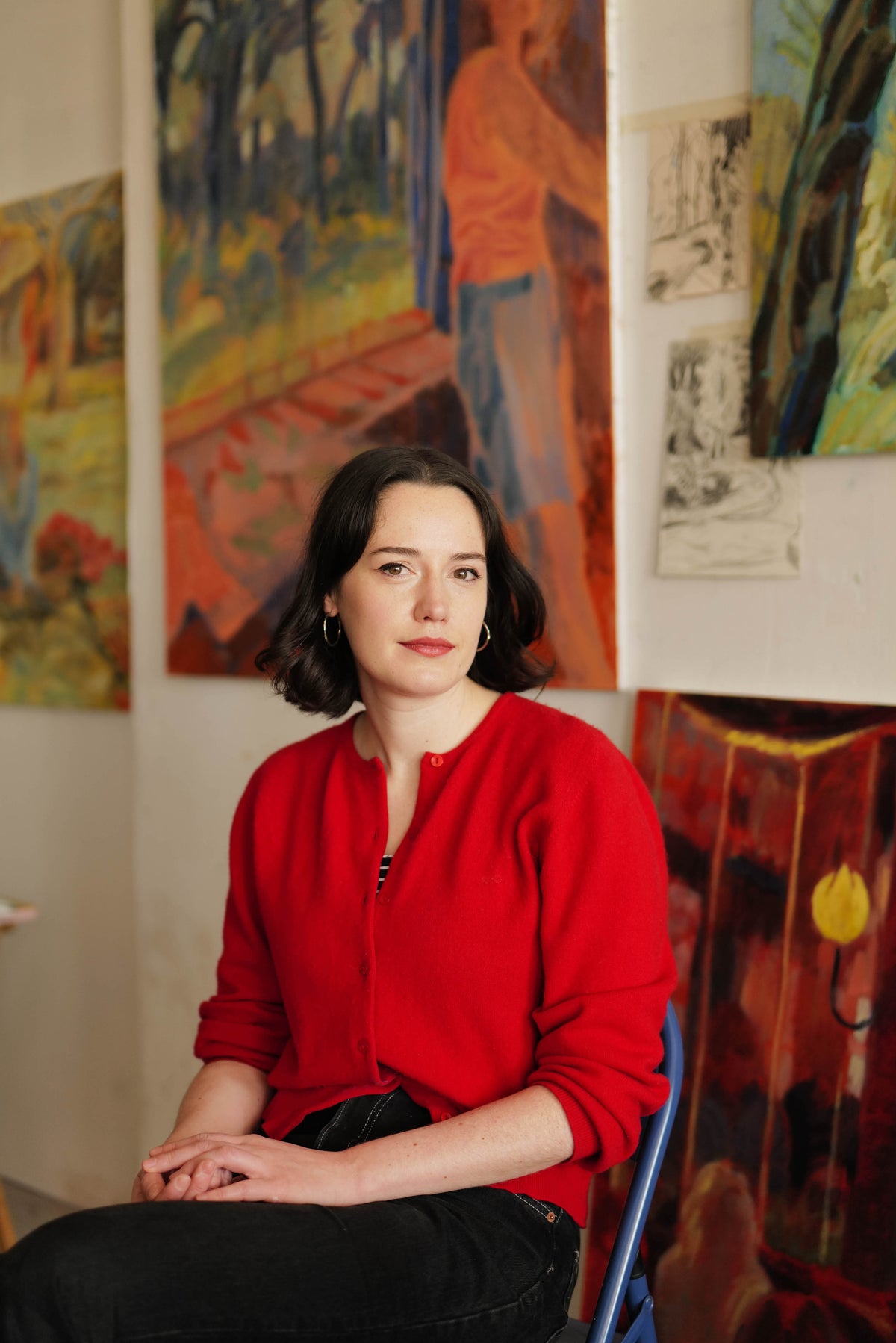
Katy Papineau
London-based figurative painter Katy Papineau's work explores the interplay of symbolism, memory and imagination. A 2019 graduate of The Drawing Year at The Royal Drawing School’s prestigious Drawing Year programme, she has since completed residencies in France, Scotland and Italy. Papineau made her solo debut with A Poison Tree at Blue Shop Gallery in July 2023.
Q: Can you tell us a bit about your art practice?
My practice begins in observations of everyday life. My starting point for a painting is always drawing from observation: I sketch in public spaces, observing people going about their lives and the interactions that take place between them. I take these drawings back to the studio, allowing the images to gestate in my mind and take on new meanings before I paint from them. I am interested in the malleability of memory and ambiguity in relationships. This is reflected in the images I make, which often have a haziness to them.
Q: How would you describe your style or creative process? What draws you to particular materials, colours, techniques etc?
I use colour and light to express emotion and atmosphere. I’ve been researching colour theory and at the moment I’m experimenting with the possibilities of more limited palettes, working with smaller and smaller slices of the colour wheel. Materiality is also important to my work – I’m often experimenting with surface texture through my use of pigment and mediums such as cold wax.
Q:What themes, concepts or processes do you tend to explore?
At the moment I’m experimenting with what I think of as memory games. I find that if I create a separation between myself and my original subject while painting, there is more space for something more personal or psychological to slip into the gap. Rather than working directly from colour sketches or photographs, I work from pencil drawings and written notes, allowing memory and emotions to influence my colour choices. Sometimes I work purely from memory, without looking at any drawings, allowing my mind’s eye and muscle memory to guide me.


Q: Can you tell us about the pieces showcased?
These paintings originated from drawings made on a residency where I worked every day in a café, observing the people who bustled in and out of the space. I used drawings and written notes to collect information about what I saw and heard. A quiet moment between an older couple, a baby staring with intense curiosity, a woman sitting alone with her head bathed in light.
Q: What is the inspiration behind this body of work?
When I go out drawing, I am often looking out for subtle moments of interaction between people. I’m interested in the fact that meanings and intentions can be obscure even to the people directly involved in a relationship. On a personal level, I find that uncertainty difficult – I want to understand other people, particularly those close to me. Examining these moments of connection and disconnection in my work helps me become more accepting of the fact that we can never truly know the minds of others.
Q: What does beauty mean to you when it comes to art?
The art that resonates with me most tends to contain something both universal and specific: images that contain observations about our shared experiences of the world, seen through the eyes of another person. The art I love allows me to experience something recognisable in a new way, gaining understanding of the inner life and specific vision of the artist.

Justine Menard
Born and raised in Paris, Justine Menard worked as a stylist before discovering glass as a medium. Through this delicate form, she explores artistic expression with an innate sense of beauty, elegance and grace. Working primarily with jewellery and objects, Justine crafts a world of purity and magic - where soft, feminine forms and organic shapes converge in timeless harmony.
Q: Can you tell us a bit about your art practice?
I’m a glassblower and multidisciplinary artist originally from Paris, now based between Barcelona and Paris. My work is rooted in a very intuitive and tactile relationship with glass — I see it as a way to capture fleeting emotions, softness, and sensuality in a material that’s both fragile and eternal. I come from a background in fashion and styling, and I think that sensitivity to form, elegance, and detail naturally transitioned into my current practice. Everything I create is made by hand, slowly and intentionally.
Q: How would you describe your style or creative process? What draws you to particular materials, colours, techniques etc?
My style is quite organic, feminine, and emotional. I’m deeply drawn to soft, flowing shapes — things that feel like they’ve grown naturally or emerged from water or the body. I work mostly with clear and pastel glass, often layering transparency with subtle colors. I love how glass can be so sensual, like skin or liquid, and how it catches the light. I often let the material lead — I don’t force it. I follow its movement and let it become what it wants to be. That dialogue with the medium is everything to me.
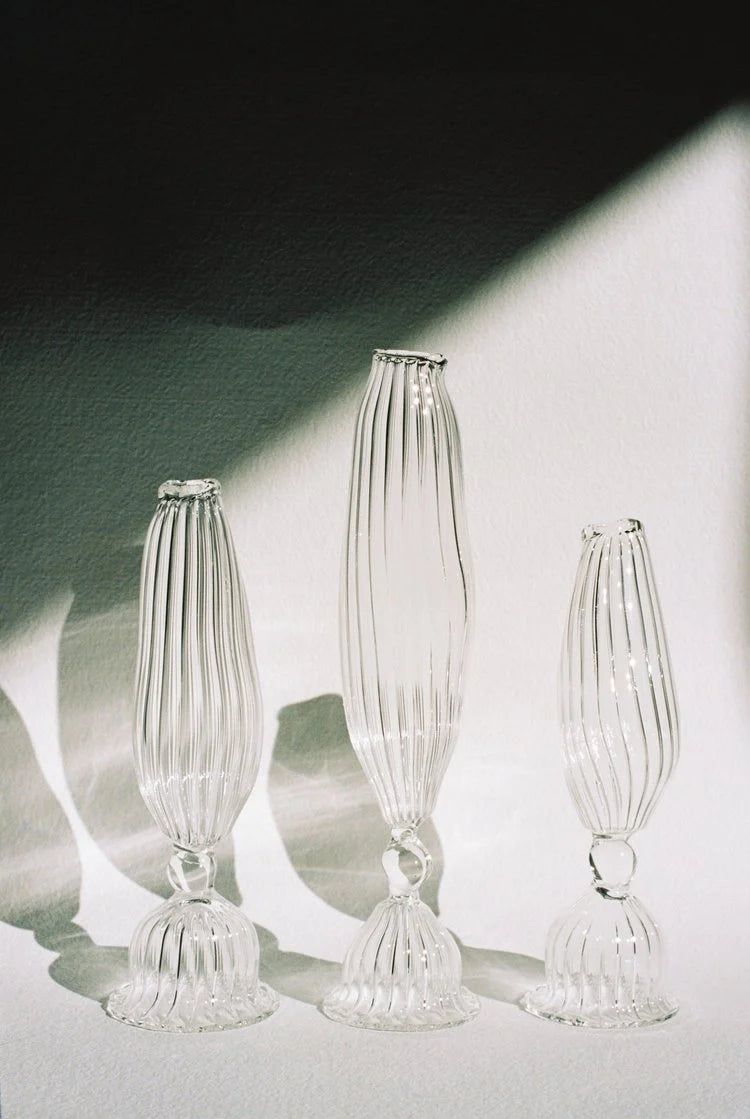
Q: What themes, concepts or processes do you tend to explore?
I’m really interested in dualities — softness and strength, presence and absence, sensuality and fragility. My work often explores femininity, intimacy, and emotion — but in a very abstract way. It’s more about evoking a feeling than telling a story. I also explore a lot through repetition and ritual — blowing glass, shaping it, reheating — it’s a meditative process, and the rhythm of that repetition is part of the meaning.
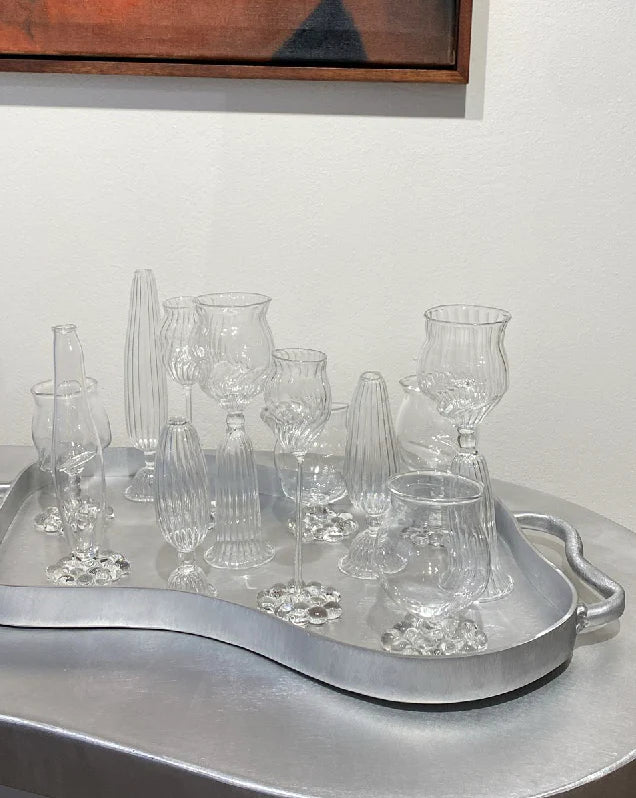

Q:Can you tell us about the pieces showcased?
The showcased pieces include the Orphée Liqueur Glass set, a pair of handcrafted, mouth-blown glasses that embody the delicate balance between fragility and strength. Each glass features a refined, lightweight upper form seamlessly connected to a solid, grounded base, symbolizing the harmony of opposites. I want to invite people to reimagine their interaction with everyday objects.
Q:What is the inspiration behind this body of work?
This work came from a very personal space. I was thinking about softness as resistance — the power of being gentle in a world that often demands hardness. I was also inspired by the quiet beauty of the everyday: There’s a quiet intimacy in these pieces — they’re about being fully present , exactly like when i am on my torch blowing glass.
Q:What does beauty mean to you when it comes to art?
For me, beauty is not about perfection, it’s about emotion. It’s the feeling something gives you when you look at it or hold it. It’s vulnerability, honesty, sensuality. Beauty in art is when a piece touches you deeply, even if you don’t know why — when it feels alive, when it breathes. I’m always chasing that — something that’s not loud, but lingers.

Dea Domus
Dea Domus is a ceramics and sculptural furniture studio led by artist Sophie Frost. Rooted in tradition, Sophie pushes the boundaries of clay to craft through one-of-a-kind, bespoke pieces. Her work blends Neolithic ceramic forms and techniques with contemporary explorations of pattern, texture, and mark-making. Through this fusion of past and present, she dissolves the lines between form and function, object and vessel.
Q: Can you tell us a bit about your art practice?
A multi-disciplinary craft studio functioning between ceramics and sculptural furniture. The foundations of my practise lie in studio pottery, where my focus is in the process of wheel throwing & hand building. I draw from my personal visual language which focuses on shape and pattern to create a range of 3D objects, both functional and ornamental.
Q: How would you describe your style or creative process? What draws you to particular materials, colours, techniques etc?
My creative process blends various methods of production. I begin with drawing and collage, which guide the development of surfaces, shapes, and scale. This foundation is then translated into my vessels, which are often thrown on the wheel and further refined through hand building techniques. My colour palettes are inspired by nature, using pure natural pigments that mirror the natural world—shades of blue, grey, green, and black. I often envision my collections through these palettes, reflecting the earth and sky, which are my greatest sources of inspiration.
Q: What themes, concepts or processes do you tend to explore?
My research focuses on Neolithic societies, particularly their relationship with matriarchy, ritual and nature. The artifacts uncovered from these ancient civilizations, often clay objects and vessels, are rich in symbolism and offer valuable insights into their cultural practices.
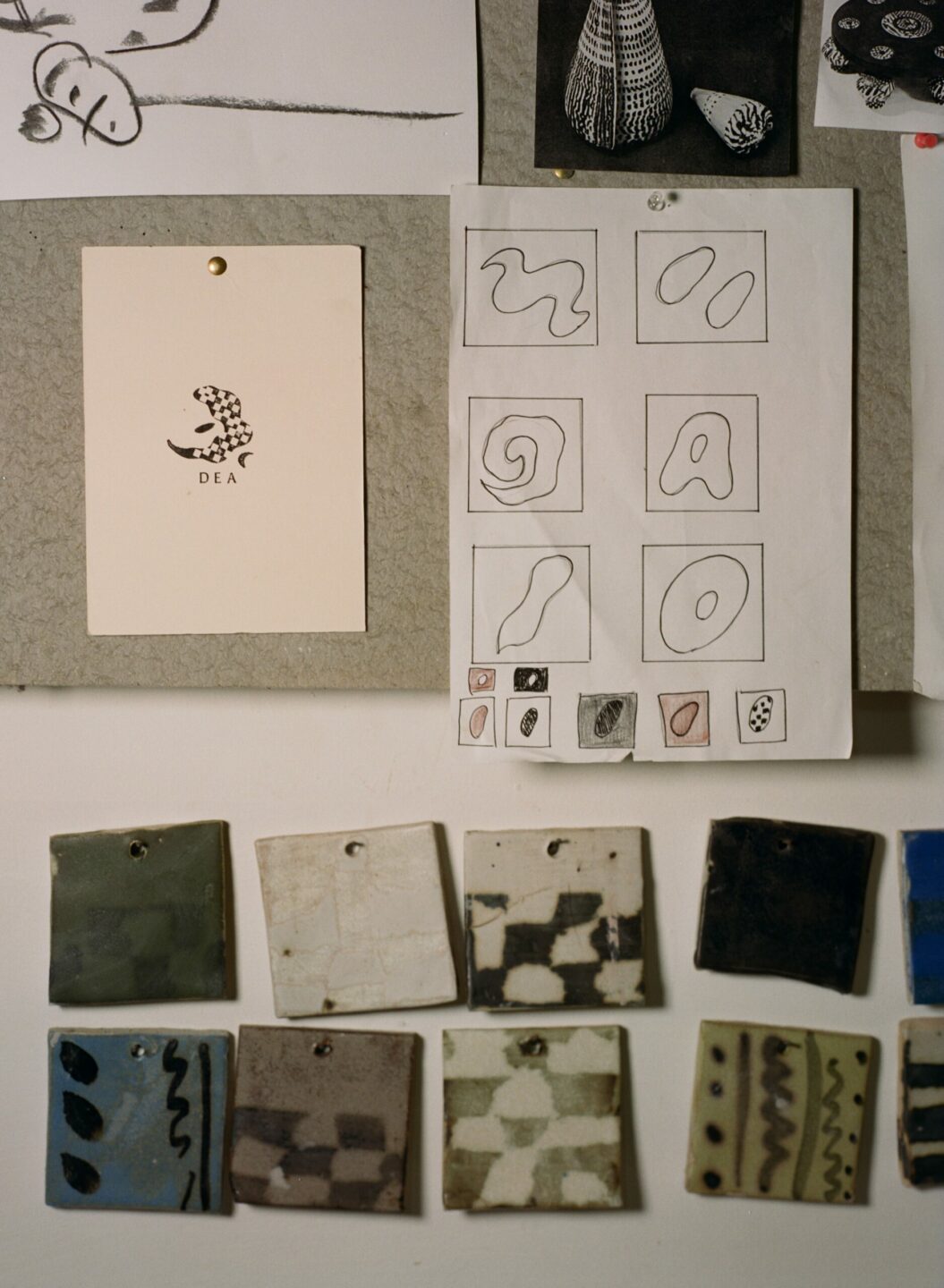

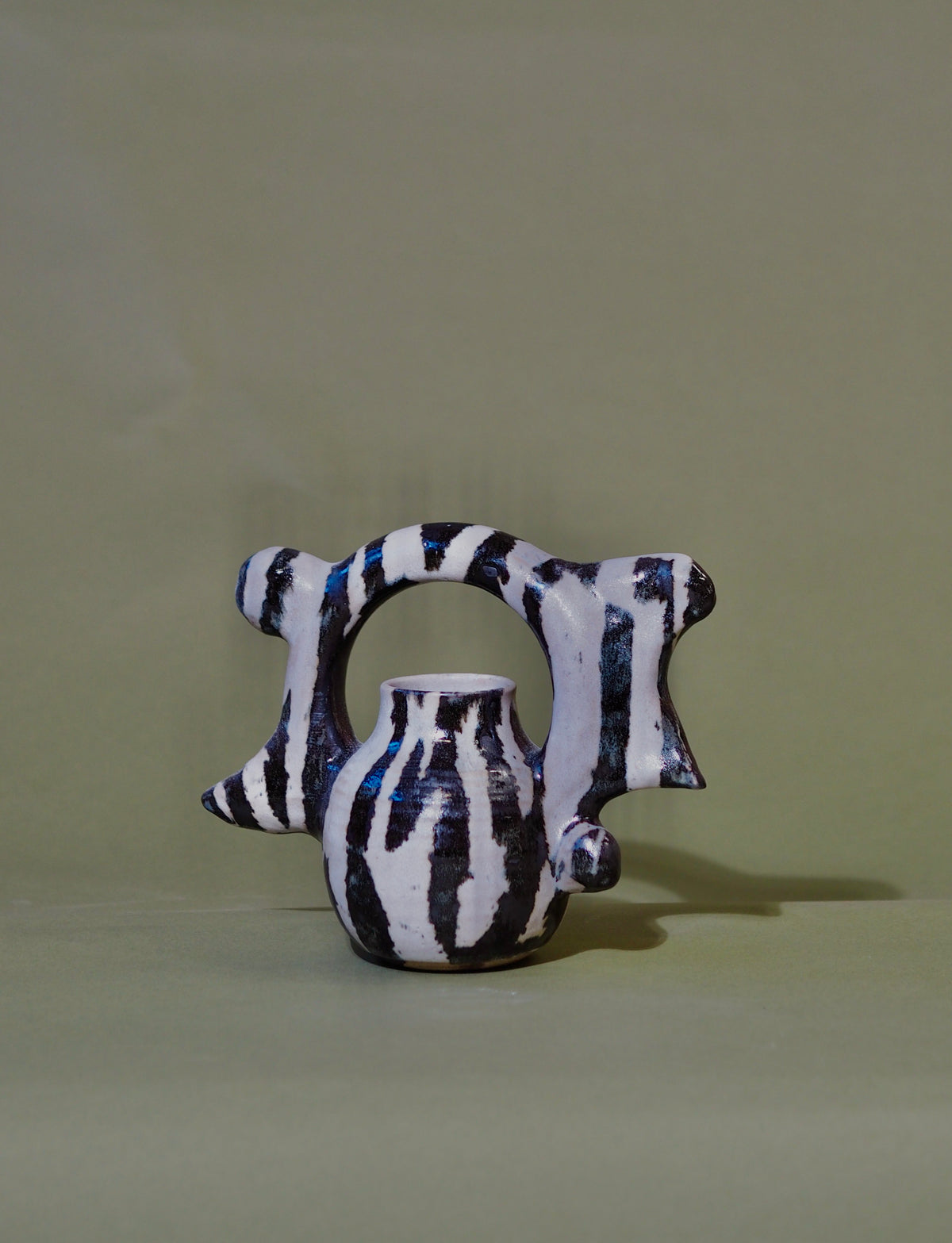
Q: Can you tell us about the pieces showcased?
“Mood in Sesklo II” is a bespoke collection developed from an ongoing exploration of the relationship between the spiritual - the representational - the metaphysical. The idea that everything is connected.
Drawing heavy inspiration from the forms of nature, the collection features wheel-thrown vessels that are adapted to evoke abstract shapes and elements, resulting in one-of-a-kind pieces that transcend traditional boundaries of ceramic forms.
Q: What does beauty mean to you when it comes to art?
For me, beauty in art is about the powerful connection between the artist, the artwork, and the viewer. It’s not just about traditional aesthetics—it’s about how a piece challenges what we expect or makes us feel understood, seen, or heard. True beauty lies in art that allows us to step into a new space, one we might not have considered or experienced before, even change our mood for the day. We may connect with something we didn’t know we were connected to. The beauty, in essence, is found in the experience the artwork gives us. The sense of self it can awaken.